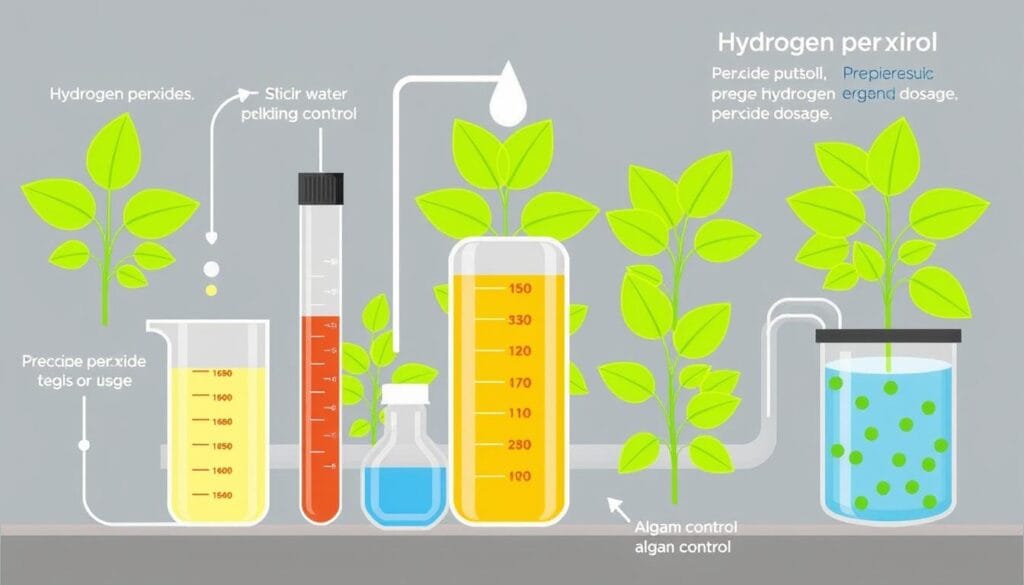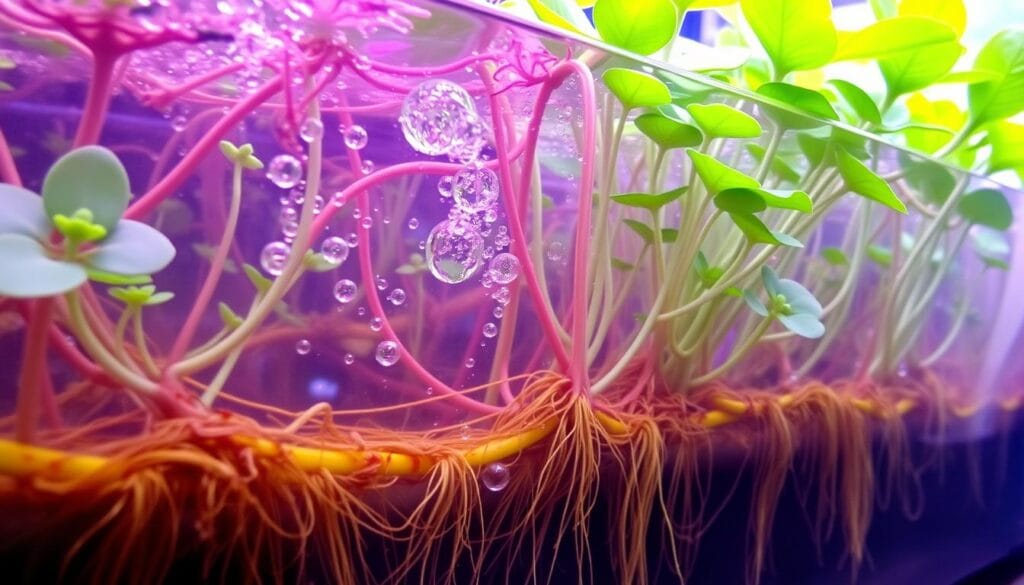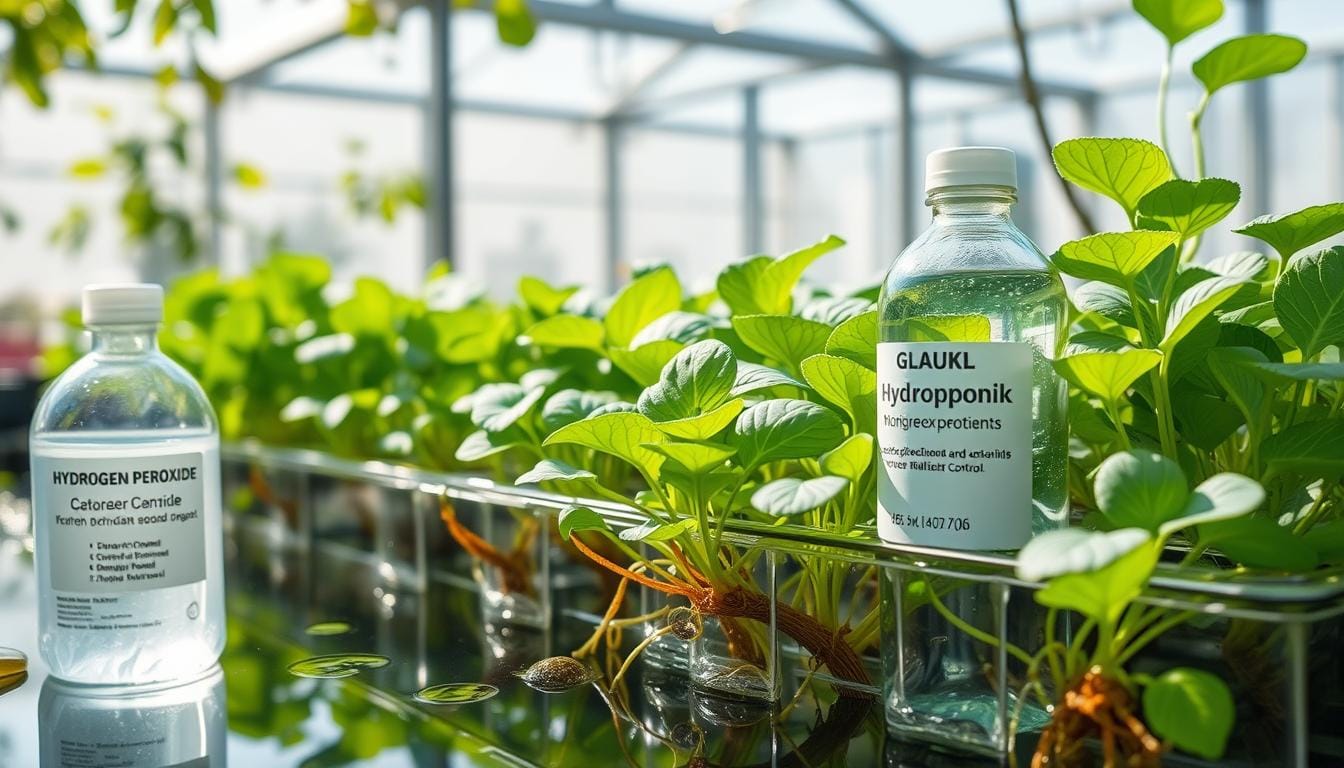Hydrogen peroxide is key in hydroponics, offering many benefits. It controls algae, enriches oxygen, and prevents pathogens. It works as a strong oxidizer, killing harmful microbes and helping roots grow well.
When used in hydroponics, it breaks down into water and oxygen. This gives plants more oxygen. It keeps the growing area clean and full of oxygen, helping plants grow better and produce more.
Key Takeaways
- Hydrogen peroxide is a versatile tool in hydroponic systems, offering benefits beyond just algae control.
- It acts as an oxidizing agent, killing harmful microorganisms and providing essential oxygen for plant roots.
- Proper dosage and application of hydrogen peroxide is crucial to maintaining a clean, healthy hydroponic environment.
- Hydrogen peroxide can be used in combination with other treatments to enhance its effectiveness in preventing and treating issues like root diseases and pathogen infestations.
- Careful monitoring and adjustment of hydrogen peroxide levels is necessary to avoid potential negative impacts on nutrient solutions and pH levels.
Understanding Hydrogen Peroxide: Chemical Properties and Safety
Hydrogen peroxide (H2O2) is a simple compound, with just one more oxygen atom than water (H2O). It’s a key oxidizing agent in hydroponics. Knowing its properties and how to handle it is crucial.
Chemical Structure and Stability
Hydrogen peroxide is unstable and breaks down into water and oxygen when it meets organic matter. This breakdown releases oxygen, making it a strong oxidizer. The speed of this breakdown depends on temperature, pH, and impurities.
Safety Precautions and Storage
For hydroponics, use 35% food-grade hydrogen peroxide. It’s a strong oxidizer that needs careful handling. Always wear gloves and goggles. Store it in a cool, dark place to avoid accidents.
Different Types and Concentrations
There are different hydrogen peroxide concentrations, like 3%, 5%, and 8%. But 35% is the standard for hydroponics. Dilute it to 3% for the best balance of safety and effectiveness.
Knowing how to handle hydrogen peroxide safely lets hydroponic growers use it effectively. It’s a powerful tool in their systems.
Hydrogen Peroxide in Hydroponics: Core Functions and Benefits
Hydrogen peroxide is key to keeping hydroponic systems healthy and productive. It fights off harmful bacteria, viruses, and fungi. This keeps pathogens and algae from harming plant growth and yield.
It also boosts oxygen in the nutrient solution. This helps roots grow strong and absorb nutrients better. A study found that using 15 ml hydrogen peroxide in one liter of water weekly makes plants healthier and stronger.
Hydrogen peroxide also helps plants fight off diseases and use nutrients better. A 2020 study showed it boosts antioxidant activity in plants, making them healthier and more resilient. Another study in 2017 found it improves plant growth and stress response.
It’s also great at removing chlorine from water. This keeps the nutrient solution pure for plant growth.
Adding hydrogen peroxide to your hydroponic system can greatly improve plant health and yields. It’s useful for sanitizing, enriching oxygen, and boosting nutrient uptake. Hydrogen peroxide is a powerful tool for hydroponic gardeners.
| Function | Benefit |
|---|---|
| Antimicrobial agent | Sanitizes hydroponic systems by combating harmful bacteria, viruses, and fungi |
| Oxygen enrichment | Promotes robust root development and nutrient uptake |
| Plant defense and nutrient utilization | Increases antioxidant activity and improves plant growth and stress response |
| Chlorine removal | Ensures purity of the nutrient solution |
Using hydrogen peroxide in your hydroponic system offers many benefits. It sanitizes, boosts oxygen, and enhances nutrient uptake. This versatile compound is essential for any hydroponic gardener looking to improve plant health and productivity.
How Hydrogen Peroxide Combats Algae Growth
Keeping your hydroponic system healthy and vibrant is key. Hydrogen peroxide is a great tool for fighting algae. Knowing how to use it can help your plants grow well without algae getting in the way.
Types of Algae in Hydroponic Systems
Hydroponic systems often face algae like brown, black, green, red, and bluish-green. Each type can cause problems, from looking bad to upsetting your nutrient balance. Knowing these algae helps you use hydrogen peroxide better.
Prevention and Treatment Methods
- Use opaque materials to block light and prevent algae growth in the first place.
- Maintain proper nutrient levels to discourage algae from taking hold.
- Regularly clean your hydroponic system to remove any existing algae buildup.
- Add 3ml of 3% hydrogen peroxide solution per liter of water every four days to combat active algae growth.
Optimal Treatment Schedules
Using hydrogen peroxide regularly is crucial. Treat your system every four days to keep algae under control. This keeps your system clean, your plants healthy, and your yields high.
Hydrogen peroxide is a game-changer for your hydroponic setup. By knowing your algae, preventing it, and treating regularly, your plants will thrive.
Oxygen Enrichment and Root Health Enhancement
Keeping your hydroponic garden’s roots healthy is key to its success. Hydrogen peroxide is a powerful tool for this. It boosts root zone health and oxygenation.
Hydrogen peroxide (H2O2) releases oxygen (O2) when it breaks down in your nutrient solution. This hydroponic root oxygenation offers many benefits for your plants’ roots:
- Promotes healthier root development and growth
- Enhances nutrient uptake and overall plant vigor
- Helps prevent common issues like root rot and other oxygen-deficiency related problems
- Especially valuable in warmer temperatures, where oxygen solubility decreases
Creating an oxygen-rich nutrient solution helps your plants thrive. The extra oxygen boosts root respiration. This makes nutrient absorption more efficient, improving root zone health in your hydroponic system.
Adding hydrogen peroxide to your hydroponic routine is easy and effective. It supports your plants’ roots and helps them grow to their full potential. By using this versatile compound, you can elevate your hydroponic gardening.
Pathogen Control and System Sterilization
Keeping your hydroponic system healthy and productive is key. Hydrogen peroxide is a powerful tool in fighting off harmful pathogens like Pythium, Fusarium, and Rhizoctonia. It kills these microorganisms without leaving harmful residues. This makes hydrogen peroxide essential for the safety and quality of your hydroponic produce.
Common Hydroponic Pathogens
Fungal infections are a big problem in hydroponics. Pythium, Fusarium, and Rhizoctonia are the main culprits. They can cause root rot, slow growth, and even destroy your crops if not stopped. Keeping the nutrient levels, pH, and oxygen right in the root zone helps prevent these infections.
Sterilization Techniques
To sterilize your hydroponic system, flush it with a hydrogen peroxide solution. This solution kills any remaining pathogens and stops mold or mildew. Use 1 teaspoon of 3% food-grade hydrogen peroxide per gallon of water.
Prevention Strategies
- Keep the nutrient solution’s pH between 5.5 and 6.5 to make it hard for pathogens to grow.
- Regularly clean and sterilize all parts of the system, like filters and lights.
- Add beneficial microbes, like Trichoderma, to fight off harmful ones.
- Make sure the root zone has good drainage and oxygen to avoid waterlogging and root rot.
Using hydrogen peroxide and a solid pathogen control plan can protect your hydroponic system. This ensures your produce is healthy and safe for your customers.
Proper Dosage and Application Methods
Using hydrogen peroxide in your hydroponic system needs the right dosage and application. Start with 3 ml of 3% hydrogen peroxide per liter of water. This is about 2-3 teaspoons per gallon.
Remember to dilute the 35% food-grade hydrogen peroxide before use. Begin with a lower dose and increase it slowly. Watch how your plants react to find the best balance for your system.
For best results, apply the hydrogen peroxide solution every four days. Mix it with half of the water and the nutrients separately. Then, combine them. This method prevents any problems in your nutrient solution.
- Use 3 ml of 3% hydrogen peroxide per liter of water or 2-3 teaspoons per gallon
- Always dilute 35% food-grade hydrogen peroxide to 3% before use
- Apply the solution every four days to maintain effectiveness
- Add peroxide to one half of the water, then mix with the nutrient solution
- Start with a slightly lower dose and gradually increase as needed, while monitoring plant response
By following these guidelines for hydrogen peroxide dosage hydroponics, H2O2 application techniques, and hydroponic nutrient solution treatment, you can effectively use hydrogen peroxide. This will help keep your hydroponic garden healthy and thriving.

Impact on Nutrient Solutions and pH Levels
Using hydrogen peroxide in your hydroponic nutrient solution has its effects. It can raise the pH of your solution. So, it’s key to keep an eye on it and adjust as needed to keep the pH between 5.5-6.5. This is the best range for most hydroponic crops.
Nutrient Interaction
Hydrogen peroxide can also affect your nutrients. It can break down iron chelates, making them less available to your plants. Watch your nutrient levels closely after using hydrogen peroxide. This ensures your plants get the nutrients they need.
pH Management Guidelines
- Check the pH of your hydroponic nutrient solution often and adjust it if needed to keep it in the ideal range.
- After adding hydrogen peroxide, keep a close eye on the pH. Use pH-up or pH-down solutions to keep it right where it should be.
- Don’t overdo it when adjusting the pH. Sudden changes can stress your plants. Make small adjustments to find the perfect spot.
Knowing how hydrogen peroxide affects your hydroponic system’s nutrients and pH is crucial. It helps your plants grow well and gives you a great harvest.
Root Zone Disease Prevention and Treatment
Keeping your hydroponic garden’s roots healthy is key. Hydrogen peroxide is a great tool for stopping and fixing root diseases. It makes the root area oxygen-rich, fighting off hydroponic root rot and other diseases.
Preventing Root Rot and Other Diseases
Using hydrogen peroxide regularly can stop root diseases. Add 1-3 ml of it to each liter of water. This stops harmful pathogens like Pythium root rot from growing.
Hydrogen peroxide boosts root health and oxygen levels. This makes it hard for disease-causing microbes to survive.
Treating Active Root Diseases
For root diseases that are already present, use more hydrogen peroxide. Mix 5-10 ml per liter to kill off the pathogens. Watch your plants closely, as this can stress them a bit. Once the disease is gone, go back to the lower dose.
Adding hydrogen peroxide to your hydroponic care is wise. It keeps roots healthy, fights off diseases, and keeps your system thriving. Use it with other good practices to tackle many root problems.
| Symptom | Potential Cause |
|---|---|
| Leaf Yellowing | Compromised roots |
| Wilting | Improper water absorption by roots |
| Slowed Growth | Diseased roots |
| Discolored Roots | Brown or black roots suggest disease |
| Unpleasant Odor | Presence of harmful pathogens |
Stay alert and proactive to keep your hydroponic root zone healthy. Use hydrogen peroxide regularly. This will help prevent and treat many root problems.

Combining Hydrogen Peroxide with Other Treatments
Keeping your hydroponic system healthy means using different treatments together. Hydrogen peroxide is great because it works well with other products. This way, you can solve more problems and keep your plants thriving.
Compatible Solutions
Hydrogen peroxide gets along well with other hydroponic treatments. For example, it pairs well with beneficial bacteria to keep the roots healthy. Organic additives like humic and fulvic acids also boost its power, helping plants absorb nutrients better.
But, not all products go well with hydrogen peroxide. Don’t mix it with products that have heavy metals or strong acids and bases. These can make both treatments less effective.
Treatment Timing and Intervals
When using many treatments, timing is key. Start with hydrogen peroxide, then wait 24 hours before adding more. This way, each treatment can do its job without getting in the way.
Make sure to check if products work well together before using them. Mixing hydrogen peroxide with the right treatments can help your hydroponic garden grow strong and healthy. It can fight off algae and diseases, making your garden a success.
| Treatment | Compatibility with Hydrogen Peroxide | Best Practices |
|---|---|---|
| Beneficial Bacteria | Compatible | Apply hydrogen peroxide first, wait 24 hours, then add beneficial bacteria |
| Organic Additives (Humic/Fulvic Acids) | Compatible | Apply hydrogen peroxide and organic additives in separate applications, following the 24-hour interval |
| Heavy Metal-based Treatments | Incompatible | Avoid mixing hydrogen peroxide with heavy metal-based products |
| Strong Acids/Bases | Incompatible | Avoid mixing hydrogen peroxide with strong acids or bases |
“By combining hydrogen peroxide with other suitable treatments, you can create a comprehensive and effective maintenance regimen that addresses a wide range of issues, from algae control to pathogen management.”
Common Mistakes and Troubleshooting
Using hydrogen peroxide in hydroponics requires careful handling to avoid mistakes. Overdosing can harm plant roots. Also, using non-food grade hydrogen peroxide can be harmful to plants and the system.
Not applying hydrogen peroxide consistently can let harmful microbes grow. Storing it in hot or sunny places can also reduce its effectiveness. To fix these problems, measure the right amount, use food-grade hydrogen peroxide, apply it regularly, and keep it in a cool, dark spot.
Watch your plants for signs of stress or nutrient needs after using hydrogen peroxide. Adjust the amount as needed. By avoiding these mistakes, your hydroponic system will work better, and your plants will grow well.

